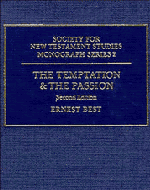Book contents
II - The Origin of Temptation
from PART I - THE TEMPTATION
Published online by Cambridge University Press: 28 October 2009
Summary
It would appear that we have left little place for Satan in the remainder of the Gospel and so we must examine those places in which he appears and those in which Jesus is said to be tempted, to discover his role therein. This will lead us to a general discussions of evil and its origin in Mark, which will in turn lead to a similar discussion of the same question in the whole of the biblical and post-biblical material.
There are two passages other than i. 12 f. in which Satan is mentioned in the Gospel. He appears first in the interpretation of the Parable of the Sower at iv. 15. It might be thought that we could evade this occurrence by arguing that the interpretation is not original; we however are concerned with the Gospel as it stands, not with what we would put in it if we were writing a life of Jesus. We must point out though that the activity of Satan in the interpretation of the parable is an activity among men; he is not seen as active in the life of our Lord. The interpretation represents for Mark an attempt to place the parable in the life of the early Church, and therefore Satan is here viewed 21s active in the lives of men. We are at the moment dealing with Satan as active in the life of Jesus and therefore may leave this reference in iv. 15 until later.
- Type
- Chapter
- Information
- The Temptation and the PassionThe Markan Soteriology, pp. 28 - 60Publisher: Cambridge University PressPrint publication year: 1990



